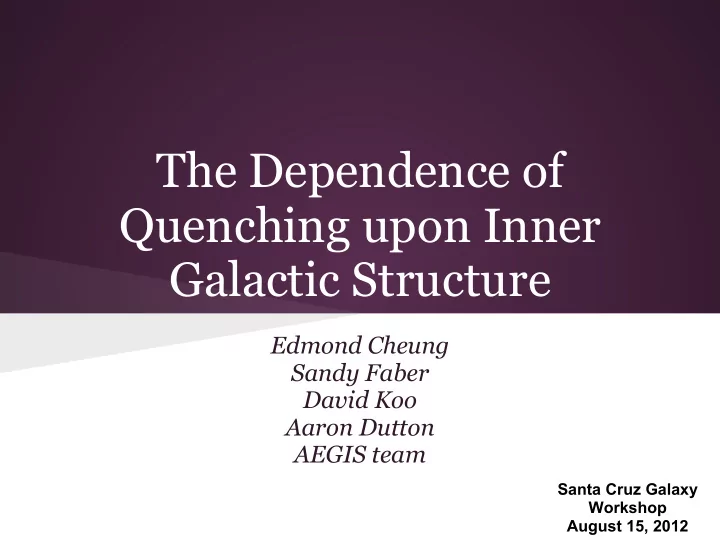

The Dependence of Quenching upon Inner Galactic Structure Edmond Cheung Sandy Faber David Koo Aaron Dutton AEGIS team Santa Cruz Galaxy Workshop August 15, 2012
What is Quiescence?
Data ● Photometry CFHT BRI ○ HST /ACS V+I imaging from AEGIS ○ ● Redshifts ○ spectroscopic redshifts from DEEP2 survey; photometric redshifts from Jiasheng ○ restrict to 0.5<z<0.8 to minimize k -corrections ● Rest-frame Magnitudes k -correct v4.2 (Blanton et al. 2007) ○ ● GIM2D bulge+disk decompositions by Luc Simard ○ V, I, r e for bulge and disk component ○ ● Stellar Masses stellar masses of spectroscopic sample from Bundy et al. 2006 ○ fit a relationship between M*/L and V, I, z ○
Results 60% 25%
Results Cheung et al. (submitted)
M * /r e Overlap Region ● Genuine inner structural difference between quenched and star-forming galaxies ○ blue cloud galaxies cannot simply fade on to the red sequence ○ migration to red sequence requires a significant rearrangement of the inner stellar mass
Color Sérsic Index Diagram ● Medians show a step-like behavior in U-B vs. log n ○ notable exceptions to this behavior are highlighted ○ only 15% of these 'outliers' are AGN ○ doubtful n due to small size and/or off- center clumps of star formation
Color Central Surface Mass Density ● Σ * 1kpc corrects the outliers ● Suggests that inner structure of galaxies is most related to quiescence
A Visual Approximation of our Conclusions UCSC AEGIS Meeting June 19-21, 2012
● Sérsic index most sharply discriminates star- forming galaxies from quiescent galaxies ○ however, ~30% of high n galaxies are still star- forming ● Central surface mass density corrects these outliers, suggesting that it is the inner structure of galaxies that is most related to quiescence ● Red sequence bulges are ~2x as massive as blue cloud bulges, while also ~2x as small, thus corroborating our conclusion that stellar mass density must absolutely increase at the centers of galaxies as they quench
Recommend
More recommend